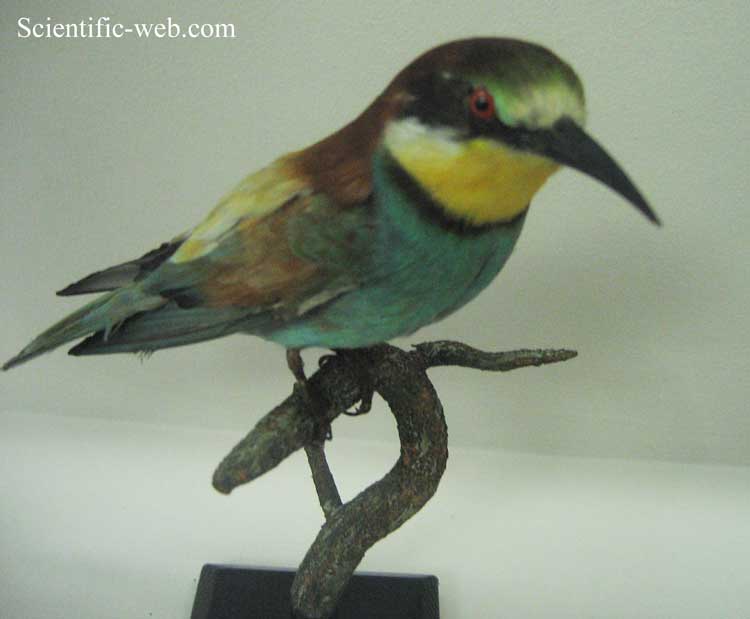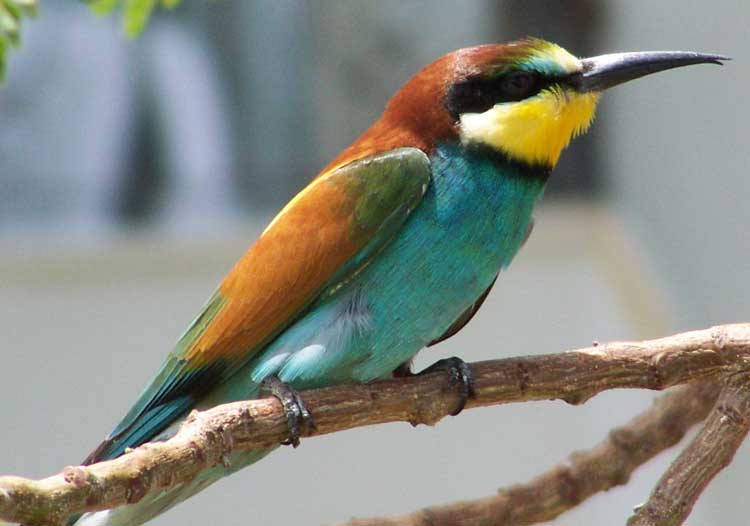
Merops apiaster, Photo: Michael Lahanas
Superregnum: Eukaryota
Regnum: Animalia
Subregnum: Eumetazoa
Cladus: Bilateria
Cladus: Nephrozoa
Superphylum: Deuterostomia
Phylum: Chordata
Cladus: Craniata
Subphylum: Vertebrata
Infraphylum: Gnathostomata
Superclassis: Tetrapoda
Cladus: Reptiliomorpha
Cladus: Amniota
Classis: Reptilia
Cladus: Eureptilia
Cladus: Romeriida
Subclassis: Diapsida
Cladus: Sauria
Infraclassis: Archosauromorpha
Cladus: Crurotarsi
Divisio: Archosauria
Subsectio: Ornithodira
Subtaxon: Dinosauromorpha
Cladus: Dinosauria
Ordo: Saurischia
Cladus: Theropoda
Cladus: Neotheropoda
Infraclassis: Aves
Cladus: Euavialae
Cladus: Avebrevicauda
Cladus: Pygostylia
Cladus: Ornithothoraces
Cladus: Euornithes
Cladus: Ornithuromorpha
Cladus: Ornithurae
Cladus: Carinatae
Parvclassis: Neornithes
Cohors: Neognathae
Ordo: Coraciiformes
Familia: Meropidae
Genus: Merops
Species: Merops apiaster
Name
Merops apiaster Linnaeus, 1758
Merops apiaster, John Gerrard Keulemans
References
Linnaeus, C. 1758. Systema Naturae per regna tria naturæ, secundum classes, ordines, genera, species, cum characteribus, differentiis, synonymis, locis, Tomus I. Editio decima, reformata. Holmiæ: impensis direct. Laurentii Salvii. i–ii, 1–824 pp DOI: 10.5962/bhl.title.542: 117. Reference page.
IUCN: Merops apiaster Linnaeus, 1758 (Least Concern)
Vernacular names
Afrikaans: Europese Byvreter
aragonés: Abellaruelo europeyo
العربية: وروار أوروبي
azərbaycanca: Qızılı qızlarquşu
башҡортса: Йәшелғош
беларуская: Залацістая шчурка
български: Обикновен пчелояд
brezhoneg: Gwespetaer boutin
буряад: Шарга балша
català: Abellerol comú
کوردی: کەندەسمە
corsu: Vespaghju
čeština: Vlha pestrá
Cymraeg: Gwybedog gwenyn
dansk: Biæder
Deutsch: Bienenfresser
Zazaki: Şalûr
Ελληνικά: Μελισσοφάγος
English: European Bee-eater
Esperanto: Eŭropa abelmanĝulo
español: Abejaruco
eesti: Mesilasenäpp
euskara: Erle-txori
فارسی: زنبورخوار معمولی
suomi: Mehiläissyöjä
føroyskt: Býflugubítur
français: Guêpier d'Europe
Frysk: Bijefretter
Gaeilge: Beachadóir Eorpach
گیلکی: کرکوره
galego: Abelleiro
עברית: שרקרק מצוי
hrvatski: Žuta pčelarica
magyar: Gyurgyalag
հայերեն: Ոսկեգույն մեղվակեր
Bahasa Indonesia: Berek-berek eropa
italiano: Gruccione
日本語: ヨーロッパハチクイ
ქართული: ოქროსფერი კვირიონი
қазақша: Сарыалқым аражегіш
ಕನ್ನಡ: ಹಳದಿಗಲ್ಲದ ಕಳ್ಳಿಪೀರ
한국어: 유럽벌잡이새
kurdî: Şehlûr
Lëtzebuergesch: Beiefrësser
lietuvių: Europinis Bitininkas
latviešu: Bišu dzenis
македонски: Пчеларка
മലയാളം: യൂറോപ്യൻ വേലിത്തത്ത
монгол: Шарга балч
Napulitano: Aparulo
Nederlands: Bijeneter
norsk nynorsk: Bietar
norsk: Bieter
occitan: Serena
ирон: Æхсыргур
polski: Żołna zwyczajna
پنجابی: یورپی مکھی-کھانا
português: Abelharuco-comum
română: Prigorie
русский: Золотистая щурка
slovenčina: Včelárik zlatý
slovenščina: Čebelar
српски / srpski: Пчеларица
Seeltersk: Europäisken Iemenfreeter
svenska: Biätare
தமிழ்: ஐரோப்பியப் பஞ்சுருட்டான்
Türkçe: Avrupa arı kuşu
українська: Бджолоїдка звичайна
Tiếng Việt: Trảu châu Âu
walon: Wespî d' Urope
吴语: 黄喉蜂虎
Zeêuws: Bieneter
中文: 黄喉蜂虎
The European bee-eater (Merops apiaster) is a near passerine bird in the bee-eater family, Meropidae. It breeds in southern Europe and in parts of north Africa and western Asia. It is strongly migratory, wintering in tropical Africa. This species occurs as a spring overshoot north of its range, with occasional breeding in northwest Europe.

European Bee-eater, Merops apiaster (*)
Taxonomy and systematics
The European bee-eater was formally described by the Swedish naturalist Carl Linnaeus in 1758 in the tenth edition of his Systema Naturae under its current binomial name Merops apiaster.[2] The genus name Merops is Ancient Greek for "bee-eater", and apiaster is Latin, also meaning "bee-eater", from apis, "bee".[3]
Description
This species, like other bee-eaters, is a richly coloured, slender bird. It has brown and yellow upper parts, whilst the wings are green and the beak is black. It can reach a length of 27–29 cm (10.6–11.4 in), including the two elongated central tail feathers. Sexes are alike. Female tends to have greener rather than gold feathers on shoulders. Non-breeding plumage is much duller and with a blue-green back and no elongated central tail feathers. Juvenile resembles a non-breeding adult, but with less variation in the feather colours. Adults begin to moult in June or July and complete the process by August or September. There is a further moult into breeding plumage in winter in Africa.[4]
Behaviour and ecology
Breeding
These bee-eaters are gregarious—nesting colonially in sandy banks, preferably near river shores, usually at the beginning of May. They make a relatively long tunnel, in which they lay five to eight spherical white eggs around the beginning of June. Both male and female care for the eggs, which they brood for about three weeks. They also feed and roost communally.
During courtship, the male feeds large items to the female while eating the small ones himself.[5] Most males are monogamous, but occasional bigamy has been encountered.[5] Their typical call is a distinctive, mellow, liquid and burry prreee or prruup.
Eggs of Merops apiaster
Feeding
Feeding bee-eater—the female (in front) waits for the male's offering
This bird breeds in open country in warmer climates. As the name suggests, bee-eaters predominantly eat insects, especially bees, wasps, and hornets. They catch insects in flight, in sorties from an open perch. Before eating a bee, the European bee-eater removes the sting by repeatedly hitting the insect on a hard surface. It can eat around 250 bees a day.
The most important prey item in their diet is Hymenoptera, mostly Apis mellifera. A study in Spain found that these comprise 69.4% to 82% of the European bee-eaters' diet.[6] Their impact on bee populations, however, is small. They eat less than 1% of the worker bees in areas where they live.[7]
A study found that European bee-eaters "convert food to body weight more efficiently if they are fed a mixture of bees and dragonflies than if they eat only bees or only dragonflies."[8]
Predation of honey bees
Bee-eater colony destroyed by bee-keepers. The entrance into the bee eater's galleries were deliberately blocked with stones
If an apiary is set up close to a bee-eater colony, a larger number of honey bees are eaten because they are more abundant. However, studies show the bee-eaters do not intentionally fly into the apiary, rather they feed on the insects caught on pastures and meadows within a radius of 12 km (7.5 mi) from the colony, this maximum distance being reached only when there is a lack of food. Observations show that the birds actually enter the apiary only in cold and rainy periods, when the bees do not leave the hive and other insect prey are harder for the bee-eaters to detect.[9]
Many bee-keepers believe that the bee-eaters are the main obstacle causing worker bees not to forage, and instead stay inside the hives for much of the day between May and the end of August. However, a study carried out in eucalyptus forest in the Alalous region, 80 km (50 mi) east of Tripoli Libya, showed that the bee-eaters were not the main obstacle of bee foraging, which is the opposite of what beekeepers think. The foraging rate was higher in presence of the birds than in their absence in some cases. The average bird meal consisted of 90.8 % honey bees and 9.2 % beetles.[10]
Predation is more likely when the bees are queening or during peak migrations, from late March till mid-April, and in mid-September. Hives close to or under trees or overhead cables are also at increased risk as the birds pounce on flying insects from these perches.[11]
References
BirdLife International (2019). "Merops apiaster". IUCN Red List of Threatened Species. 2019: e.T22683756A155512816. doi:10.2305/IUCN.UK.2016-3.RLTS.T22683756A155512816.en. Retrieved 12 November 2021.
Linnaeus, Carl (1758). Systema Naturae per regna tria naturae, secundum classes, ordines, genera, species, cum characteribus, differentiis, synonymis, locis (in Latin). Volume 1 (10th ed.). Holmiae:Laurentii Salvii. p. 117.
Jobling, James A (2010). The Helm Dictionary of Scientific Bird Names. London: Christopher Helm. pp. 50, 251. ISBN 978-1-4081-2501-4.
RSPB Handbook of British Birds (2014). UK ISBN 978-1-4729-0647-2.
Avery, MI; Krebs, JR; Houston, AI (1988). "Economics of courtship-feeding in the European bee-eater (Merops apiaster)". Behavioral Ecology and Sociobiology. 23 (2): 61–67. doi:10.1007/BF00299888. S2CID 13553144.
Higes, Mariano; Martín-Hernández, Raquel; Garrido-Bailón, Encarna; Botías, Cristina; García-Palencia, Pilar; Meana, Aránzazu (2008). "Regurgitated pellets of Merops apiaster as fomites of infective Nosema ceranae (Microsporidia) spores". Environmental Microbiology. 10 (5): 1374–1379. doi:10.1111/j.1462-2920.2007.01548.x. PMID 18218034.
Roulston, TH; Goodell, K (2011). "The role of resources and risks in regulating wild bee populations". Annual Review of Entomology. 56: 293–312. doi:10.1146/annurev-ento-120709-144802. PMID 20822447.
Judith Goodenough; Betty McGuire; Elizabeth Jakob (2009). Perspectives on Animal Behavior. John Wiley & Sons. p. 268. ISBN 978-0-470-04517-6.
"Prigonirea prigoriei. [Myths and truths about honey bees and bee eaters ]" (in Romanian). Romanian Ornithological Society. Retrieved 2018-06-27.
Alfallah, H.M. "The impact of the Bee-eater Merops apiaster on the behavior of honey bee Apis mellifera L. during foraging" (PDF). Mansoura Journal of Plant Protection and Pathology, 1(12): 1023-1030. Archived from the original (PDF) on 2018-06-27. Retrieved 2018-06-27.
Carabott, Sarah (2015-10-26). "Bee-eater is not to blame for decline in honey bees". Times of Malta. Valletta. Retrieved 2018-06-27.
Retrieved from "http://en.wikipedia.org/"
All text is available under the terms of the GNU Free Documentation License


